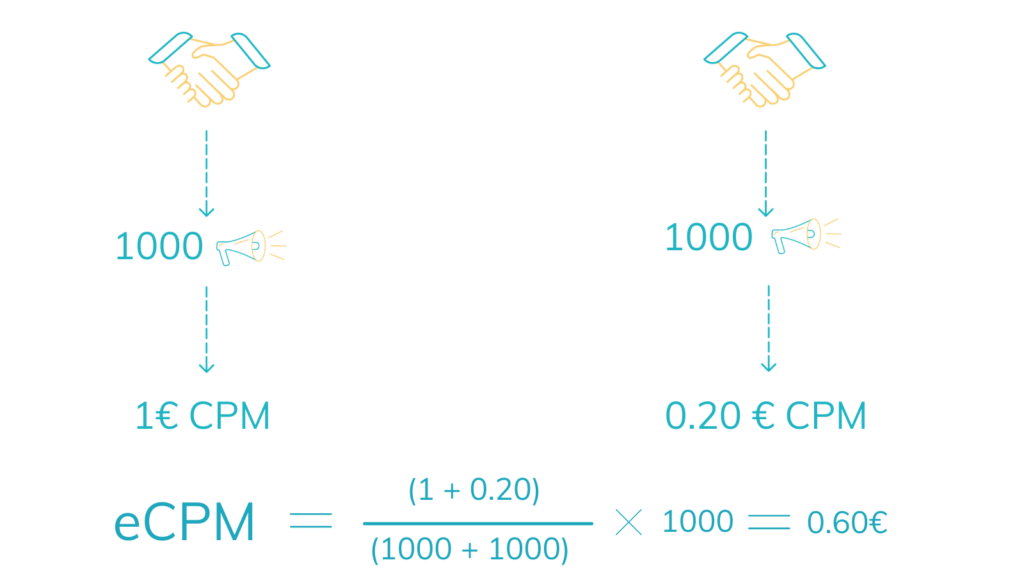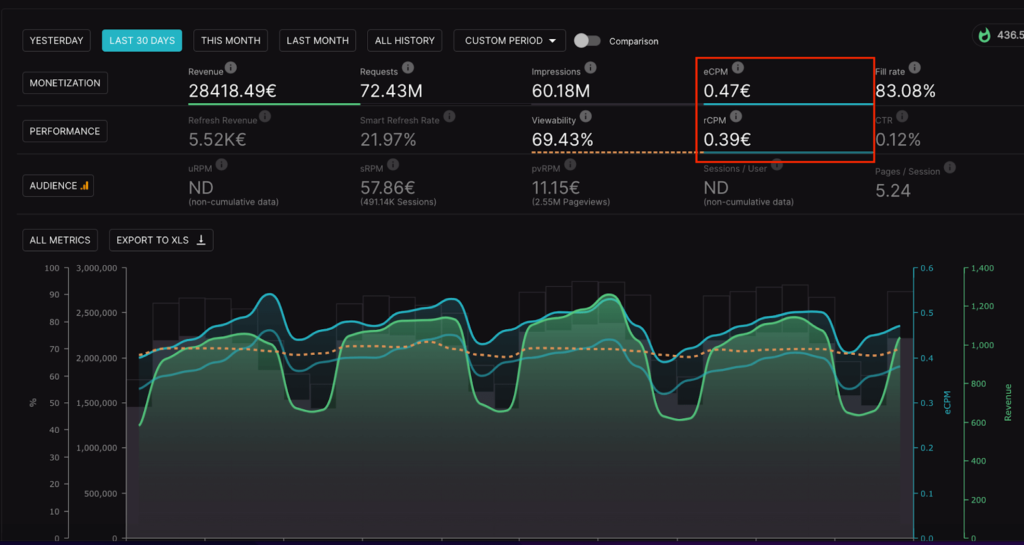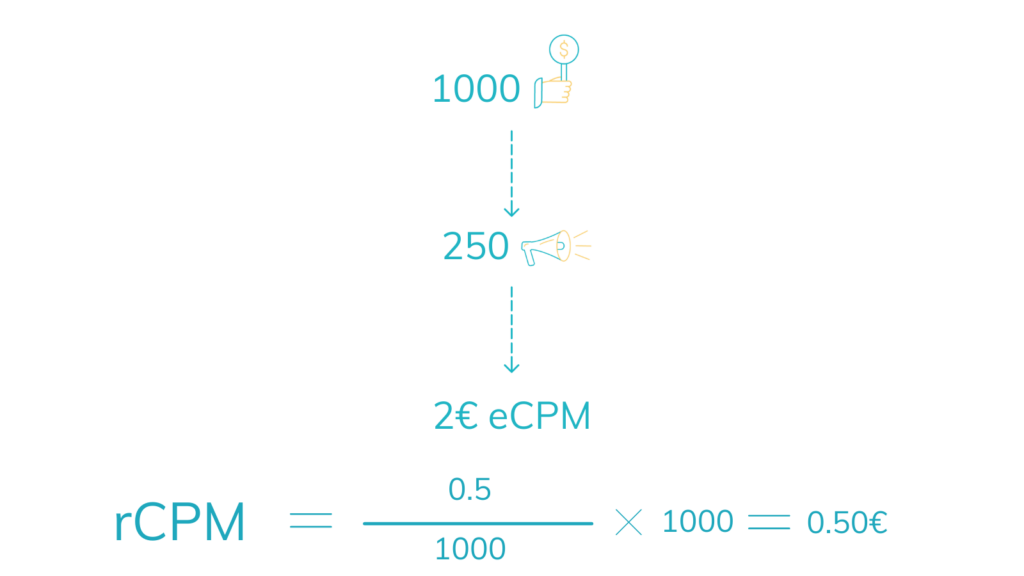eCPM, rCPM y Tasa de Relleno | Métricas de Monetización Importantes
Anteriormente, explicamos las diferencias entre eCPM y CPM. Este artículo ampliará el debate al comparar eCPM, rCPM y tasa de relleno. Aprenderás en qué se diferencian estas métricas, cómo se calculan y en cuál debes fijarte a la hora de evaluar el rendimiento de la monetización.
Pero antes, refresquemos nuestros conocimientos sobre el eCPM.
¿Qué es el eCPM?
eCPM significa «coste efectivo por cada mil impresiones». Se calcula para demostrar los ingresos publicitarios generados a partir de 1000 impresiones publicitarias. El eCPM es la media de varios CPM.
En otras palabras, el eCPM proporciona la media combinada de todas las ofertas de los anunciantes por las impresiones de tus anuncios.
Fórmula del eCPM

Ejemplo de eCPM
Imaginemos que hubiera dos campañas en el sitio web del editor.
El CPM de la primera campaña fue de 1 € y el de la segunda de 0,20 €, y cada campaña compró 1.000 impresiones publicitarias.
En este caso, el editor generó unos ingresos totales de 1,2 euros (1 euro + 0,20 euros) por cada 2000 (1000 + 1000) impresiones publicitarias. Por lo tanto, el eCPM fue de 0,60 € (1,2 € / 2000 x 1000 = 0,60 €).

Fuente: CPM vs eCPM | Diferencias, fórmula y cómo calcularlos
¿Qué es el rCPM?
El rCPM, también conocido como RPM, significa «coste real por millar». El cálculo del rCPM muestra el precio medio de 1000 solicitudes de anuncios.
La principal diferencia entre eCPM y rCPM es que con el rCPM los ingresos del editor se basan en el total de solicitudes de anuncios en lugar de en las impresiones de anuncios.
Por lo tanto, el rCPM tiene en cuenta la tasa de relleno. El rCPM se calcula como si todas las solicitudes de anuncios se llenaran, y si algo no se llena, pasa a la suma de ingresos con un valor de 0. Obviamente, el rCPM siempre será inferior al eCPM.

Solicitud de anuncios frente a impresión
Una solicitud de anuncio se refiere al número de veces que el sitio web solicita un anuncio. Esto no significa que el anuncio aparezca de manera automática. Una impresión publicitaria define el número de veces que un anuncio ha aparecido y ha sido visto por un usuario.
La razón por la que no todas las solicitudes de anuncios se llenan con impresiones de anuncios se ve influenciada por muchos factores, como el comportamiento del usuario, la tasa de rebote, el tiempo de carga del anuncio, la velocidad de carga del sitio web, etc.
*Si utilizas Google AdSense, no podrás ver cuántas solicitudes de anuncios has recibido. A no ser que utilices un servidor de anuncios, por ejemplo, Google Ad Managersólo podrás ver las impresiones de los anuncios. Los editores que tienen su propio servidor de anuncios pueden ver las métricas del rCPM.
Fórmula del rCPM

Ejemplo de rCPM
Imaginemos que hubiera una campaña en el sitio web del editor que generará 1000 solicitudes de anuncios en total y que el precio del eCPM fuera de 2 euros. Sin embargo, los anuncios sólo se mostraron 250 veces. Eso significa que el editor vendió 250 impresiones publicitarias de las 1000 solicitudes de anuncios realizadas.
A partir de la fórmula del eCPM, llegamos a la conclusión de que el total de ingresos publicitarios generados por los editores fue de 0,5 euros. Por lo tanto, el rCPM fue de 0,50 euros.

¿Qué es la tasa de relleno?
La tasa de relleno es el porcentaje de impresiones de anuncios que ha recibido tu anuncio, dividido por el total de solicitudes de anuncios y multiplicado por el 100%.
Fórmula de la tasa de relleno

Ejemplo de tasa de relleno
Imaginemos de nuevo la misma campaña publicitaria en el sitio web del editor que generó 1000 solicitudes de anuncios. Sin embargo, los anuncios sólo se mostraron 250 veces. Esto significa que sólo 250 solicitudes de anuncios se transformaron en impresiones de anuncios. En este caso, la tasa de relleno del editor fue del 25 %.

La tasa de relleno suele verse influenciada por la falta de demanda o por un precio base mínimo establecido. En este caso, el editor debe utilizar un passback o contabilizar las impresiones no realizadas como pérdidas.
¿Qué métrica elegir para la comparativa?
En general, se recomienda tener en cuenta tanto el eCPM como el rCPM a la hora de evaluar el rendimiento de la monetización.
Por ejemplo, una SSP gana la subasta, pero el usuario abandona la página antes de que el anuncio tuviera tiempo de cargarse, lo que deja la impresión sin cubrir. Este tipo de discrepancia publicitaria puede observarse al comparar eCPM y rCPM.
Sin embargo, si deseas evaluar los ingresos publicitarios de un socio de monetización específico, elige la métrica rCPM para la comparativa. Si tu rCPM es mayor, tus ingresos publicitarios aumentarán. Dado que el rCPM incluye el valor de la tasa de relleno, su cálculo será más preciso que si utilizas únicamente el eCPM.
Ten en cuenta que un eCPM alto con una tasa de relleno baja equivale a un rCPM e ingresos totales más bajos. Por lo tanto, no puedes basarte sólo en el eCPM porque existe la posibilidad de que la tasa de relleno sea inferior a la deseable.
Para terminar
Ahora que ya sabes en qué se diferencian eCPM, rCPM y tasa de relleno, el siguiente paso es mejorar el valor de cada impresión publicitaria, que es exactamente donde Setupad puede ayudarte.
Mediante el uso del wrapper de header bidding , Setupad puede aumentar el precio de cada impresión vendida en al menos un 30 %. Nuestra solución puede enviar un anuncio a la página de forma casi inmediata cuando se activa la solicitud de anuncio, lo que aumentará respectivamente tus ingresos publicitarios. Pruébalo al registrarte.


